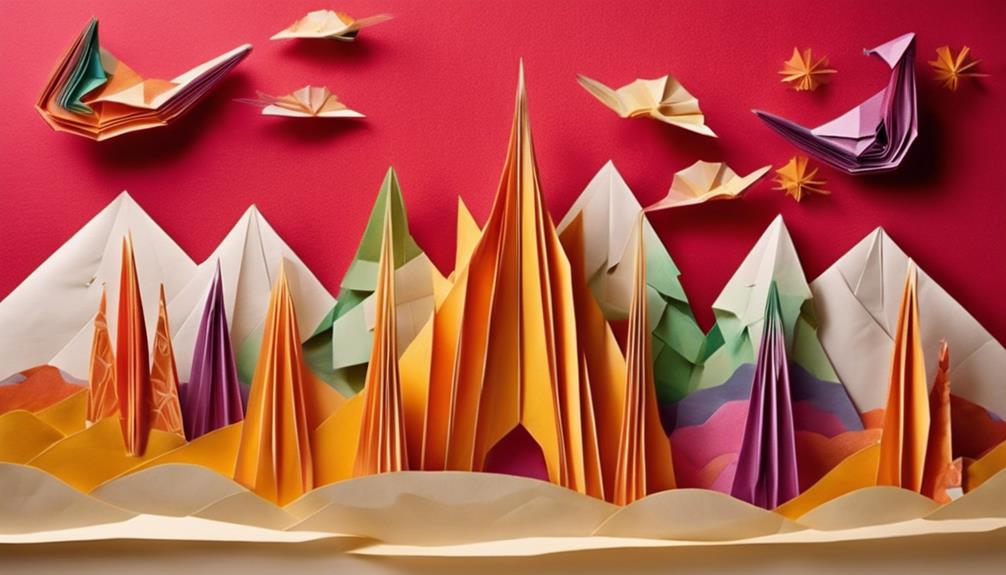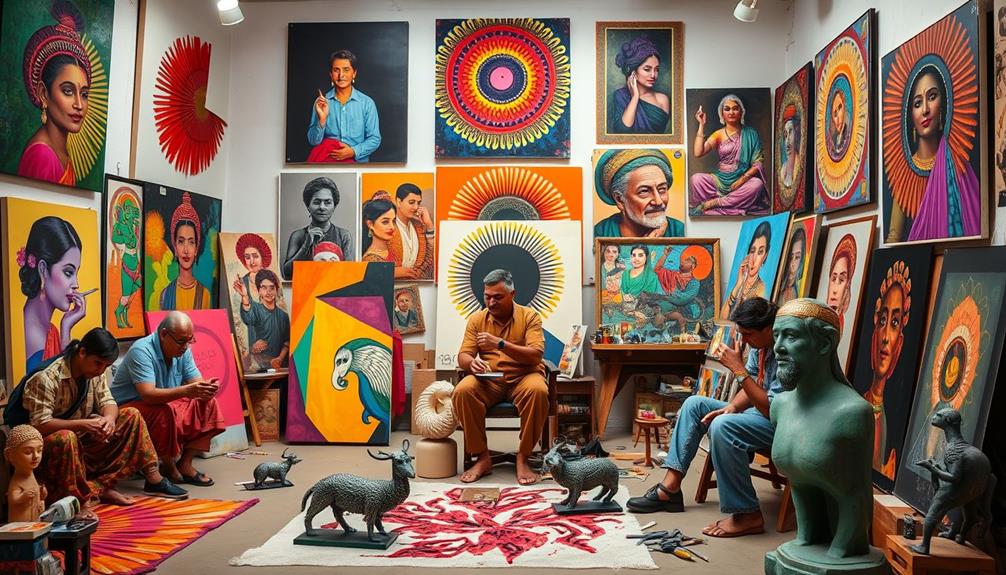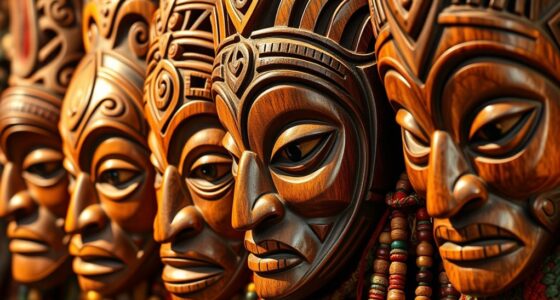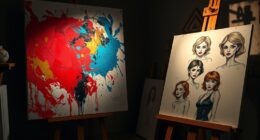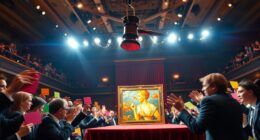The bizarre art movement inspired by Arabian Nights blends surrealism, fantasy, and exoticism to immerse viewers in enchanting worlds of magic and mystery. This unique artistic approach captures the essence of Arabian culture through fantastical imagery, vibrant colors, and whimsical interpretations. The infusion of surreal elements and exotic flair creates a mesmerizing blend of styles, drawing audiences into spellbinding narratives beyond imagination. This movement impacts vintage illustrations by blending diverse cultural influences, shaping depictions with mystique and richness. Illustrators like Kay Nielsen and Edmund Dulac revolutionize interpretations, showcasing a fusion of Asian folklore and Arab iconography.
Key Takeaways
- Infuses surrealism, fantasy, and exoticism.
- Transports to imaginative worlds.
- Adds mystery with Arabian culture.
- Blends styles for magical allure.
- Influences vintage Arabian Nights illustrations.
Origins of Arabian Nights Illustrations
Arabian Nights illustrations emerged in the 18th century, showcasing varying levels of authenticity to Arab culture. Initially, these illustrations were often vague European interpretations rather than accurate depictions of Arab environments. However, as the 19th century progressed, artists aimed for more precise representations, endeavoring to capture the essence of Arab settings more authentically. This evolution in artistic interpretation marked a significant shift from the earlier, less culturally accurate illustrations. Over time, the visual representations of Arabian Nights tales grew to depict more genuine Arab environments, reflecting a deeper understanding and appreciation for the culture.
These illustrations not only influenced the way Arab culture was depicted in art but also impacted other forms of literature. The fantastical elements and vivid imagery found in Arabian Nights illustrations inspired fantasy literature and realistic novels alike, showcasing the enduring influence of these visual representations across different cultures and time periods.
Influence of Art Deco Movement

Influenced by the Art Deco movement prominent in the 1920-30s, Vera Bock's illustrations for Arabian Nights in 1946 showcased a unique style that integrated intricate details and bold geometric patterns. Her work reflected the essence of Art Deco with sleek lines and a modern aesthetic, setting her apart within the vintage illustration scene.
The Art Deco movement left a significant imprint on Vera Bock's illustrations, evident in her use of line art to create intricate designs and geometric shapes that captivated viewers. Her artistic influences likely drew from the theatre, movies, and plays of the Art Deco era, enriching her creations with a touch of nostalgia and sophistication.
Community suggestions further support the presence of Art Deco influences in Bock's work, highlighting her originality and skill in translating the essence of a bygone artistic movement into captivating illustrations.
- Vera Bock's illustrations for Arabian Nights in 1946 showcased intricate details and bold geometric patterns.
- Her work reflected the essence of the Art Deco period with sleek lines and a modern aesthetic.
- Bock's artistic influences likely stemmed from the theatre, movies, and plays of the Art Deco era.
- Community suggestions pointed to Art Deco influences in Bock's vintage illustrations.
Unique Elements in Vera Bock's Art
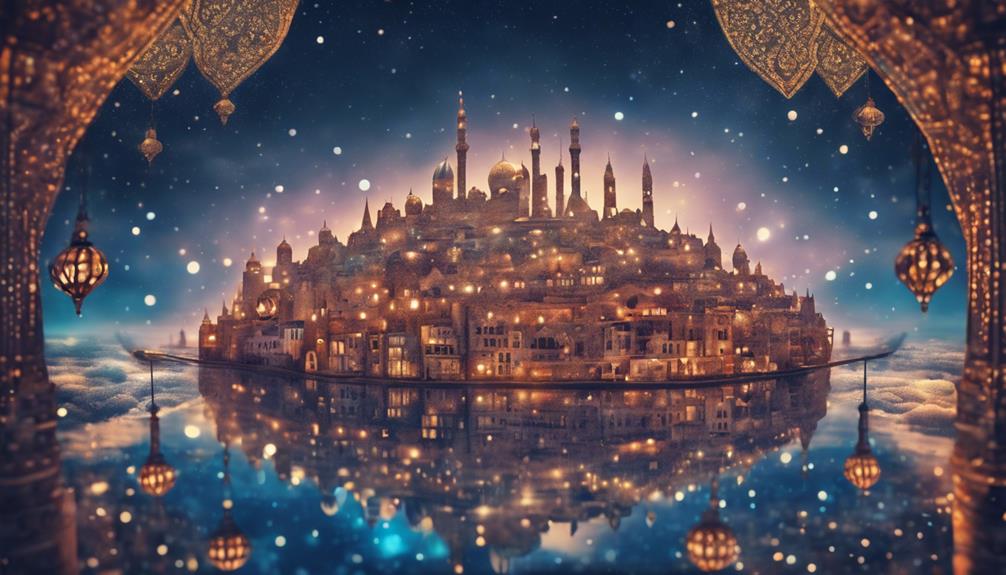
Vera Bock's artwork showcases a distinctive blend of intricate line art and detailed patterns, reflecting a unique interpretation that intertwines elements of the Art Deco movement with a touch of exoticism.
Her illustrations, particularly those for Arabian Nights dating back to 1946, demonstrate a fusion of Art Deco influences from the 1920-30s with a hint of exotic flair.
Bock's style is characterized by the meticulous craftsmanship of her line art and the incorporation of intricate patterns that add depth and richness to her pieces. This combination sets her work apart, creating a visual language that captivates viewers with its elegant complexity.
Drawing inspiration from various sources such as theatre, movies, and other visual arts of her era, Vera Bock's illustrations stand out for their unique blend of Art Deco aesthetics and exotic elements, making them a remarkable contribution to the world of artistic expression.
Intricate Details in Line Art
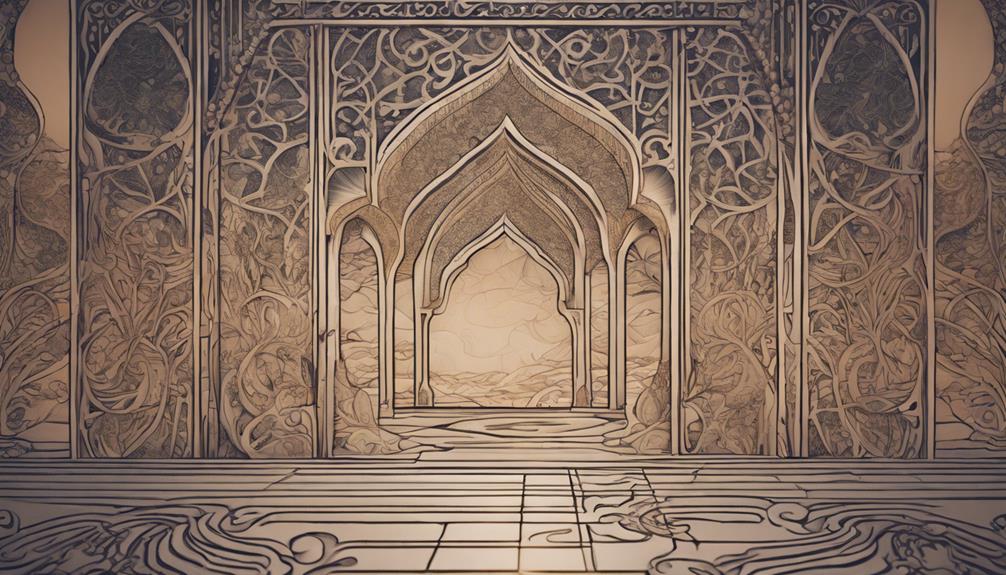
Line art illustrations in the Arabian Nights style captivate viewers with their intricate patterns and details, showcasing a level of craftsmanship that adds depth and richness to visual storytelling.
Artists meticulously craft fine lines and delicate patterns to infuse complexity and beauty into their work, allowing for precise and intricate depictions that enhance the overall aesthetic appeal of the artwork.
The intricate details in line art not only bring elegance and sophistication but also serve as a canvas for symbolism, enriching the narrative and inviting viewers to explore hidden meanings within the art.
Detailed Patterns in Art
Elaborate patterns intricately woven into the line art of Arabian Nights-inspired illustrations intricately capture the essence of richness and mystique within the tales. Artists meticulously craft these detailed patterns to enhance the visual storytelling of the Arabian Nights entertainments.
The intricate patterns in line art serve to:
- Depict the opulence: By intricately detailing patterns, artists bring to life the luxurious settings and grandeur found in Arabian Nights stories.
- Evoke exoticism: The use of complex patterns adds an exotic flair to the illustrations, transporting viewers to the enchanting world of the Arabian Nights.
- Enhance the mystical elements: Detailed patterns in line art help convey the magical and mystical aspects present in the Arabian Nights tales.
- Create a mesmerizing experience: The depth and texture provided by intricate patterns make the illustrations visually engaging, drawing viewers into the enchanting narratives of the Arabian Nights.
Symbolism in Line Art
Intricate details woven into the line art of Arabian Nights-inspired illustrations symbolize themes, emotions, and cultural elements from the tales, enhancing the visual storytelling experience. The meticulous craftsmanship in Vera Bock's line art captures the essence of Arabian Nights, conveying symbolism that adds depth and richness to the artwork. Through the intricate use of lines, Bock masterfully represents the cultural elements and themes present in the tales, creating a visual narrative that immerses viewers into the enchanting world of Arabian Nights.
To delve deeper into the symbolism found in Arabian Nights-inspired line art, let's explore a breakdown of how intricate details are utilized to convey various themes, emotions, and cultural elements:
| Themes | Emotions |
|---|---|
| Love and Betrayal | Excitement |
| Adventure | Mystery |
| Magic | Intrigue |
| Courage | Wonder |
| Friendship | Enchantment |
Nostalgic and Elegant Interpretation

The nostalgic and elegant interpretation of the Arabian Nights art movement showcases a timeless fusion of Arabian influences with modern elegance.
Through artists like Vera Bock, the intricate line art illustrations evoke a sense of mysticism reminiscent of the 1920-30s Art Deco era.
Timeless Arabian Influences
Drawing upon nostalgic and elegant interpretations, artists in the Bizarre Art Movement skillfully infuse timeless Arabian influences into their creations. To better understand this fusion, consider the following:
- Surreal Elements:
The artists blend surreal aspects with classic Arabian influences, creating a mesmerizing visual experience.
- Whimsical Interpretations:
Through whimsical and dreamlike depictions, the movement captures the essence of Arabian Nights tales, evoking a sense of wonder and magic.
- Fantastical Imagery:
Artworks within this movement often feature intricate details and vibrant colors, reminiscent of the rich folklore found in Arabian stories.
- Timeless Appeal:
By offering a fresh perspective on Arabian Nights, the Bizarre Art Movement brings a modern twist to traditional themes, showcasing the enduring allure of Arabian influences in art.
Incorporating these elements, artists craft pieces that not only pay homage to classic Arabian tales but also breathe new life into these timeless narratives through their unique and imaginative interpretations.
Modern Elegance Retold
With a nod to the past, artists like Vera Bock infuse modern elegance into their interpretations of Arabian Nights through Art Deco-inspired illustrations. Drawing inspiration from the Art Deco era of the 1920s, Bock's intricate line art reflects a sophisticated blend of nostalgia and elegance in her depictions of Arabian Nights tales. Her unique artistic approach pays homage to the classic stories while adding a contemporary touch through the incorporation of Art Deco elements.
Vera Bock's illustrations stand out for their Art Deco influences, reminiscent of the 1920-30s style, which bring a fresh perspective to the Arabian Nights narratives. Through her work, Bock offers viewers a glimpse into a bygone era while infusing the tales with a sense of modernity and refinement.
The nostalgic and elegant interpretation showcased in Bock's illustrations elevates the Arabian Nights stories to a new level, enchanting audiences with a harmonious fusion of past and present.
Captivating Blend of Styles
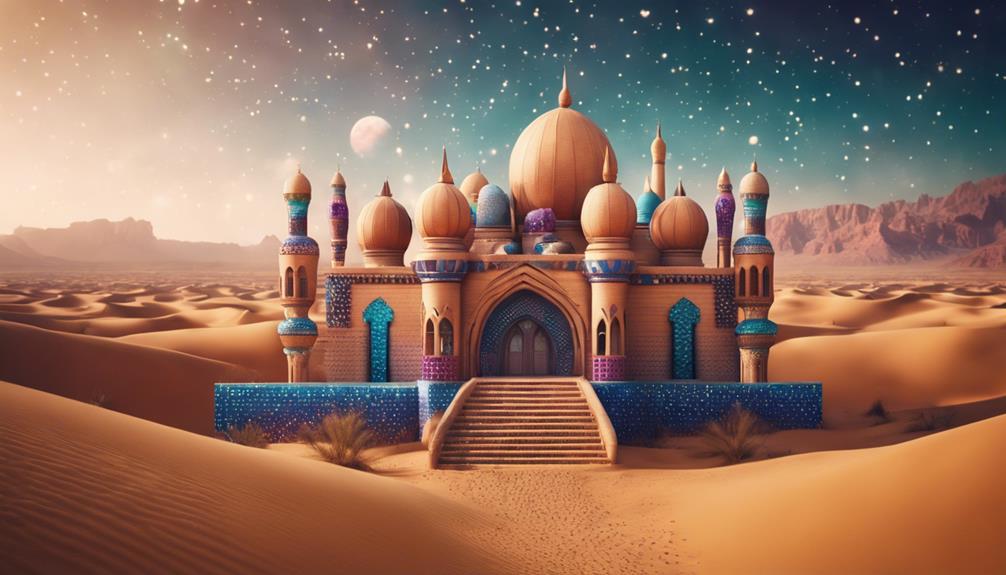
Artists in the Bizarre Art Movement captivate audiences with their mesmerizing blend of surrealism, fantasy, and exoticism in their interpretations of Arabian Nights tales. This enchanting mix of styles brings to life the mesmerizing world of Arabian Nights through unique artistic expressions. Here's why this blend is so compelling:
- Surrealism: Artists infuse elements of the unexpected and the dreamlike into their creations, creating a sense of otherworldly wonder.
- Fantasy: The incorporation of fantastical elements like magical creatures and whimsical landscapes transports viewers to worlds beyond imagination.
- Exoticism: The use of exotic motifs and settings adds an air of mystery and allure, evoking the richness of Arabian culture.
- Mysticism and Enchantment: The overall atmosphere of mysticism and enchantment in these artworks draws viewers into a world of magic and intrigue, inspired by the enchanting tales of Arabian Nights.
Impact on Vintage Illustrations

Vintage illustrations influenced by Arabian Nights tales intricately blend diverse cultural influences to create visually enthralling narratives. Artists such as Kay Nielsen and Edmund Dulac revolutionized the interpretation of Arabian Nights stories through their intricate and elaborate illustrations.
These vintage artworks often transport viewers to exotic settings, meticulously capturing the essence of the tales. Victorian Orientalism played a significant role in shaping the artistic depiction of Arabian Nights, infusing the illustrations with a sense of mystique and allure.
The fusion of Asian folklore and Arab iconography in vintage illustrations resulted in a unique visual storytelling experience that continues to captivate audiences. Illustrators like Arthur Rackham and Walter Crane also left their mark on the evolution of Arabian Nights illustrations, each contributing with their distinct styles and interpretations.
The legacy of these artists lives on through their timeless illustrations, showcasing the enduring impact of Arabian Nights on the world of vintage art.
Frequently Asked Questions
What Was the Influence of the Arabian Nights?
The influence of the Arabian Nights is vast and enduring, transcending various art forms. Its exotic settings, mystical characters, and adventurous plots have inspired literature, visual arts, music, films, and fashion.
Artists worldwide have drawn upon the enchanting tales to create imaginative works that continue to resonate with audiences. The Arabian Nights' legacy showcases its timeless appeal and ability to spark creativity and innovation across different artistic mediums.
What Book Was Inspired by Arabian Nights?
A book inspired by Arabian Nights is 'Tales from 1,001 Nights,' featuring 50 vibrant illustrations by Salvador Dalí.
Dalí's unique artistic style adds a surreal and exotic dimension to the classic Arabian Nights stories.
The book offers a visual interpretation of the tales, enhancing the reader's experience with Dalí's imaginative illustrations.
Dalí's illustrations capture the essence of the exotic settings and characters from the Arabian Nights, showcasing his contribution to the artistic legacy of the tales.
What Inspired Arabian Nights?
The Arabian Nights tales were primarily inspired by a blend of Arabian, Egyptian, Indian, and Mesopotamian cultures. These diverse influences contributed to the fantastical and exotic elements found in the stories.
Artists drew inspiration from the mystical and alluring themes present in the Arabian Nights narratives, leading to a rich cultural tapestry that continues to captivate and influence artists across various mediums.
What Is the Bizarre Art Style?
The Bizarre art style is a mesmerizing blend of surrealism, symbolism, and fantasy that challenges traditional artistic norms. It features surreal, dreamlike imagery with intricate details, often portraying bizarre creatures and distorted figures.
Artists like Salvador Dalí and Max Ernst were prominent figures in this movement, using inspiration from fantasy, mythology, and the subconscious mind to create otherworldly compositions. This unique style invites viewers into a world of strange and imaginative possibilities.
Conclusion
To sum up, the Arabian Nights art movement has left a lasting impact on the world of vintage illustrations. Artists like Vera Bock showcase a unique blend of styles that captivate viewers. While some may view this art as bizarre or unconventional, its intricate details and nostalgic elegance offer a revitalizing perspective that challenges traditional norms.
Embracing the influence of the Art Deco movement, these illustrations continue to inspire and intrigue audiences with their mesmerizing beauty.
